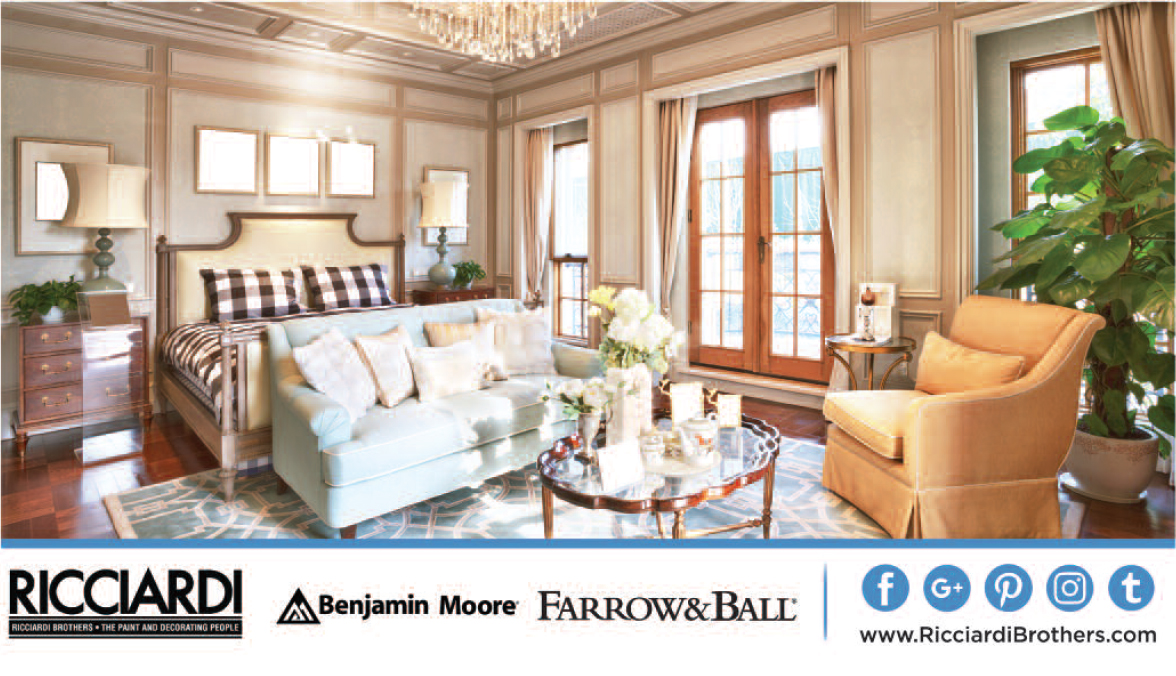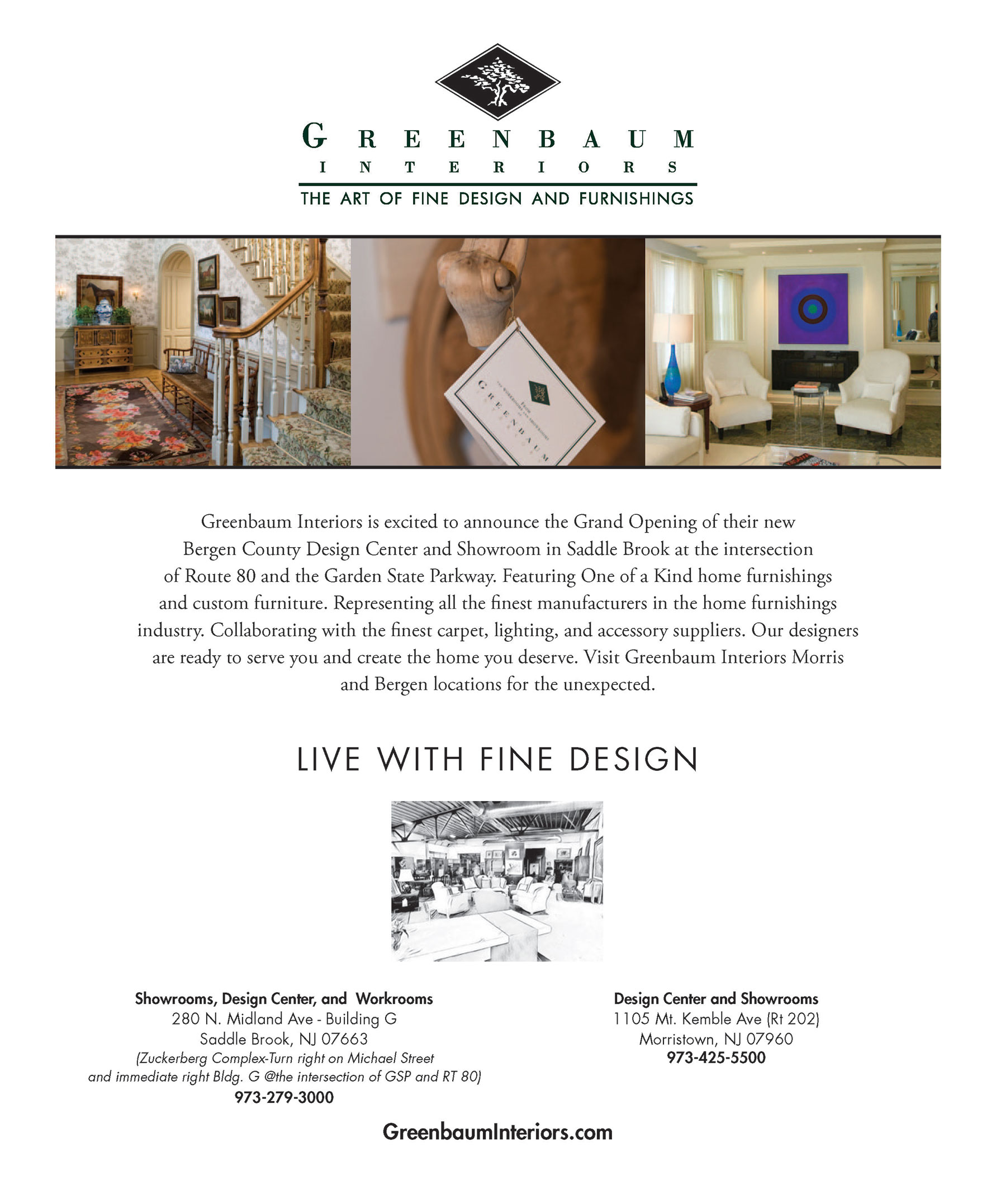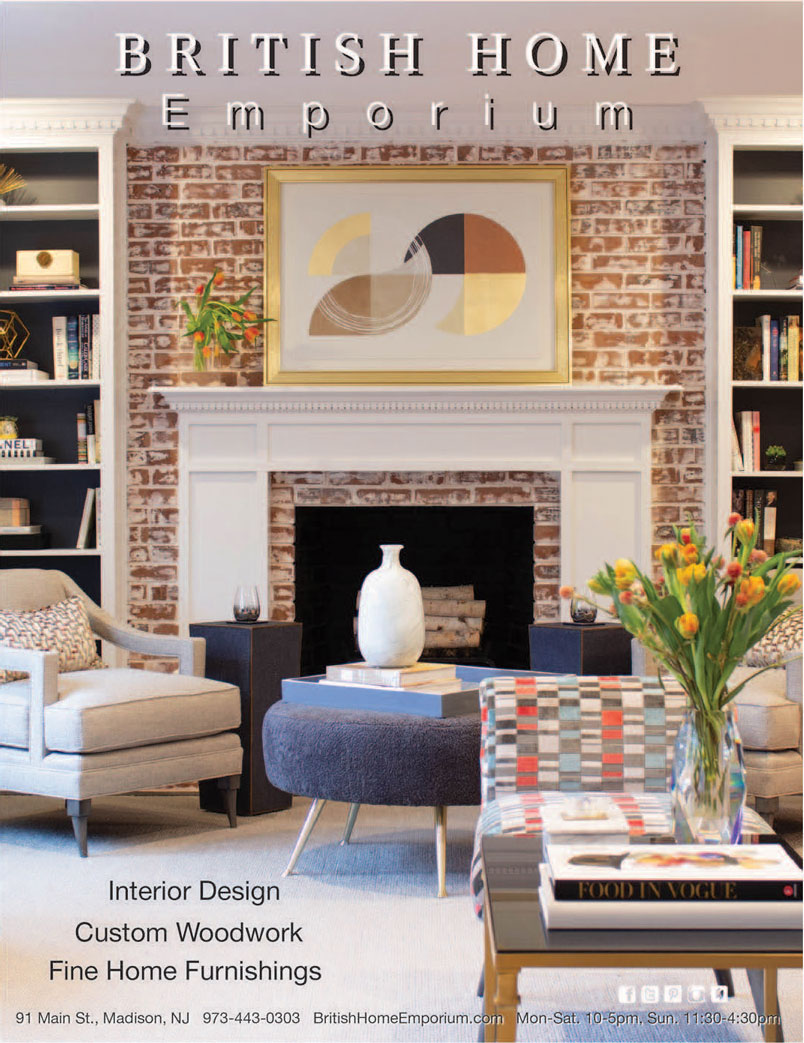- 384 Springfield Ave. Summit NJ 07901
- (908) 277-0400
- visit website
- 317 Springfield Ave Summit NJ 07091
- (908) 277-4440
- visit website
- 1105 Mt. Kemble Ave. (Rt. 202) Morristown NJ 07960
- (973)425-5500
- visit website
- 344 Millburn Ave. Millburn NJ 07041
- (973)258-0000
- visit website
- 711 Mountain Ave. Springfield NJ 07081
- (908)688-9416
- visit website
- 91 Main St. Madison NJ 07940
- 973-443-0303
- visit website
Nothing says more about you than the interior of your home. Yet so often, we look at our surroundings and think, Is this really me? At moments like these, you may want to consider professional help. A shrink? Probably not. A designer? Most definitely. Indeed, sometimes the task of minding your manor is best left to someone with a keen and objective eye. Enter Clodagh, a legend in the design world who has worked in 90 countries and lent her talents to everything from cosmetics packaging to major hotels. Her inspirational and lifeenhancing designs feature sustainable materials and embrace Feng Shui, Chromotheraphy and Biophilia to create a signature look, structure and flow. Sarah Rossbach, a friend and colleague, connected with Clodagh in her Manhattan offices. There she manages the Clodagh Collection—an online showroom of home furnishings and accessories—and Clodagh Design, her design services studio.
EDGE: How do you feel about the old saying, Neer make friends with your interior decorator?
Clodagh: It’s the absolute opposite. The first large job I got, my client looked me up and down and said, “Come out to dinner.” Other designers had told me, “Never go out to dinner with your client!” But my client said, “I will never hire anyone for anything unless I can sit down at the dinner table and have a conversation and communicate well with them.” And that was a very wise thing.
EDGE: So what kind of expectations should each person have when they start working with an interior designer?
Clodagh: You should expect a designer to work as a travel guide to your own life. Although you may not know it, everybody possesses his or her own innate good taste. The role of a designer is to help you explore how you want to live—how you want to actualize your life in your home, how you want to see your children in a play space, so they can make a mess and have fun doing it. When working with me, you should expect to explore your lifestyle and discuss what you expect in your own home. And when I get those down into what I call a program, then I can start to design the project, and get it built and finished. I approach design using the four C’s: Contemplate your space; Cleanse your life of unwanted and unused things; Clarify your goals, needs and desires; and Create a space that is yours at the core.
 EDGE: What is step one when choosing a designer?
EDGE: What is step one when choosing a designer?
Clodagh: The best thing you can do before interviewing designers is to go to a consultant who represents a lot of designers. That person will recommend a match for you. Or you can look at a lot of design magazines and start pulling out photos of what appeals to you, and then find out who designed them. Never analyze it—just know that something appeals to you. Hold on to this visceral reaction to the space. I think the best thing is to look at yourself, your family, your partner and really figure out how you want to live.
EDGE: At what point is the right time to start talking to an interior designer?
Clodagh: As soon as you realize you’ve done enough research yourself and you need some guidance.
EDGE: Is it okay to use a designer you find intimidating or overpowering?
Clodagh: No. Do not use an interior designer who intimidates you. You should never feel afraid to bring something up. Or have to endure a designer flouncing around telling you that you have terrible taste and an object you love “has to go.” At the same time, you do want someone strong, and you need to trust his or her taste. There should be mutual trust. It’s about the conversation. You need to be verbally compatible before you can be visually compatible. Because if you feel any tension, stress or negative reaction, or hidden agenda, it’s not for you. You don’t dictate to them, they don’t dictate to you.
EDGE: What happens when a client won’t part with something god-awful?
Clodagh: Usually the god-awful thing leaves without me having to do anything at all. If it’s been in storage, the client looks at it in the new environment and says, Oh, it doesn’t fit that well.
EDGE: You ask your clients a lot of questions before taking a job. What are the best questions a client asks you— the questions that tell you that the relationship is going to work well?
Clodagh: “Can you help me to live the way I want to live?” or “How can you guide me to have the sort of environment where I can have peace, balance and live harmoniously?” Really, the best thing a client can do for me is describe their ideal lifestyle, and then ask me how I can achieve it for them. And like any good conversation, I interject and suggest. I’m working with a client now who likes working in a really dark office. So I have to balance that darkness with enough light that I feel will be comfortable for him, position his desk properly, add the kind of color that will give the room a boost, and then go with it. And I need to temper his love of darkness with his wife’s love of light.
EDGE: Yin and yang.
Clodagh: Exactly. Another good question people ask is, “How can you do my children’s room?” I find children’s rooms to be over-stuffed and prefabricated in the parents’ mind, with little elephants painted on walls, when actually children are the most artistic creatures in the world. I love children and how their minds work. I install in their rooms chalkboards or dry point boards to use their markers on, so they can enjoy their environment. If it’s a house, I’ll make a room that’s specifically for them. It’s their room where they can make a mess and leave it if they need to—and not feel they have to clean up because Mommy or Daddy is coming. I get the joy that children feel in the spaces I design. I love that they’re empowered.
EDGE: What are the questions a client should listen for from a designer?
Clodagh: A designer should be asking you, “How can I help you live the way you want to live?”
EDGE: That’s a very spiritual approach.
Clodagh: Yes, there’s no such thing as an inanimate object. You’re working with people to achieve a spatial, visual and visceral harmony. And harmony is very hard to quantify. I sometimes tell my clients when they are choosing a chair to close their eyes. Sit in it and close your eyes and feel what’s the sensation. I find most clients focus on the visual. Susan Sontag said, “Sight is the most promiscuous of all the senses.” But in design, our other senses are equally important. So we need to explore all our feelings. For instance, we have a client in Texas who told us she has a very stressed-out life and that soaking every day in a warm tub helped relax her. So we focused a lot of energy and budget on creating an extraordinary bathroom. She brings into this beautiful space flowers and candles, and when she steps into her tub that is her time, where she releases her emotional and physical toxins. It’s a cleanse, where she regains herself.
EDGE: What do you get from creating a home that you don’t get from a corporate job?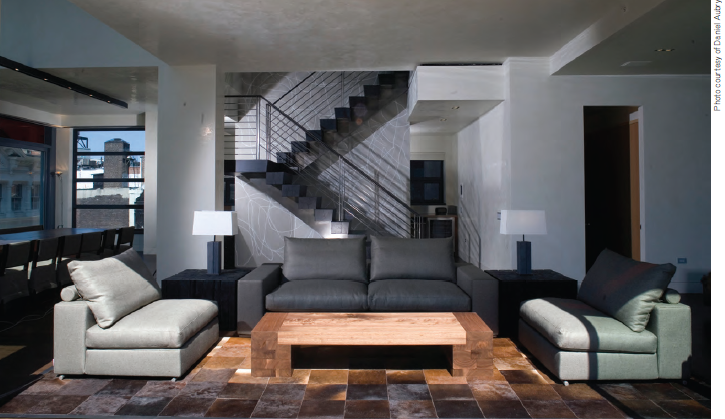
Clodagh: With a home, if the family is happy and comfortable, they disappear. If not, you get telephone calls. With a corporate job, years down the road, people still refer to the design. People working in a large music office I designed 20 years ago still tell me how they love working in that space.
EDGE: What does a great client bring to the experience so you have a wonderful collaboration?
Clodagh: Challenge!
EDGE: In terms of interior design, what is the “shelf life” of a Clodagh job?
Clodagh: I’m having lunch today with someone whose apartment I designed 23 years ago. She and it are still going strong. Some old clients will call and ask me to freshen up my existing design after many years. They’ll invite me to have a look around, and then not allow me to touch anything. Just freshen it up. Maybe new sheets, new drapes, new shades. My feeling is good design should not have a shelf life. I work to create a timeless design.
Don’t be misled by the racy cover slugs on your favorite supermarket magazines.
Solving tricky “bedroom problems” is not the exclusive domain of sex columnists.
For countless millions of troubled couples, the answer isn’t the art of love, but the art of placement.
AHong Kong-based movie director sought to smooth his turbulent marriage by trading in his traditional king-sized bed for one with rounded corners. All in the spirit of taking the edge off the relationship. In California, parents of four daughters in their twenties painted each of their bedrooms peach, a color the Chinese associate with romance and flirtation. To ensure future wedding bells. Having trouble in your marriage? Still looking for that special someone with whom to share your life? Do you sleep like a baby—a colicky one? Are you restless when you should be resting, waking up in the morning jumpy and nervous? Do you suffer from constant headaches or stomach cramps? Before contacting your local couples counselor, sleep specialist or gastroenterologist, consider this: your bedroom might be suffering from bad feng shui.
Feng shui, the ancient Chinese art of placement, addresses the environment to achieve peace, harmony and tranquility. In a bedroom, a delicate balance must be struck between serenity and suggestiveness. Calming aspects are desirable and contribute to sweet, langorous slumber, but in a marriage or relationship, desire and intimacy also need to be stoked. We spend one-third of our lives in our bedroom, where we rest, relax and recharge our energies. No wonder that, to the modern feng shui expert, the bedroom is one of the most important areas of your home. Indeed, for thousands of years, the Chinese have believed that where you sleep will influence how you sleep—that the structure and layout of your bedroom can affect your well being. When arranging a bedroom, certain ancient Chinese principles should be employed: the flow of ch’i (which translates as “energy”), the balance of yin and yang, and the wholeness of tao (which translates as the “way of nature”). Common and uncommon sense also are invaluable. In a bedroom, to the Chinese, position is an important consideration—of the bed location, that is. Ideally the bed should be cater-corner to the room’s entrance, with a view of the door so that you can comfortably see anyone entering and not be surprised. This position is called the commanding position; it gives you a sense of control over your environment. A poorly placed bed may disrupt your sleep at night and make you edgy and unbalanced during the day. Given that the ideal bed-to-door relationship is not always possible, the best cure is to hang a mirror in a way that reflects the door toward you as you lie in bed. In some cases, a bed lies between two opposing windows, so a draft blows continually, disturbing sleep. This can be cured by hanging wind chimes, a crystal, or light between the windows, thus symbolically disbursing the draft.

“Whether you’re looking for a little luck or just hoping
to get lucky, a little feng shui can go a long way.”
Avoid locating your bed under a load-bearing beam. If it runs down the center, it will be divisive to a married couple. One couple in Manhattan rarely slept together an entire night. The wife always got up in the middle of the night and slept in the guest bedroom. Her midnight rambling ended after they moved the bed out from underneath the beam.
Similarly, avoid having a beam running over your stomach or you may experience cramps and intestinal problems. A newer aspect to modern feng shui deals with all the senses—including lighting and tactile elements—in creating a romantic environment. While a good, bright light is fine for reading in bed, a softer light or pleasantly scented candle will enhance the romantic mood. Deep, slow music is also conducive to intimacy. In addition, silky, velvety fabrics create comfort and help fan the flames of love. Carpets that feel good under foot are preferable to hard sisals or cold wood floors.
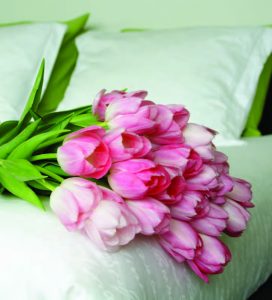
Color also is important in a bedroom. While you should always select the colors you love, it’s worth noting that pink is best for romance. Light green and pale blue are also good, as they symbolize hope and development. And peach may be the way to go if you’re still in search of that special someone. Finally, it’s worth mentioning the importance of purging your bedroom of any keepsakes or reminders of failed relationships. Keep it positive. Flowers and happy images are far more effective at creating an atmosphere conducive to a happy connection. Indeed, whether you’re looking for a little luck or just hoping to get lucky, a little feng shui can go a long way.
Editor’s Note: Sarah Rossbach is the author of Feng Shui: The Art of Chinese Placement, which was described by The New York Times as the “bible of the practice.”


